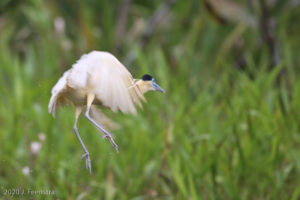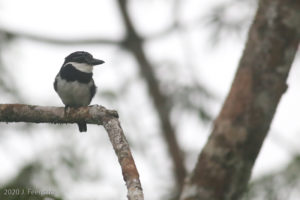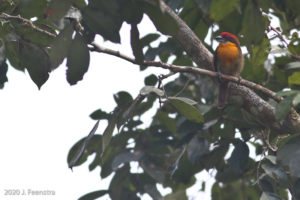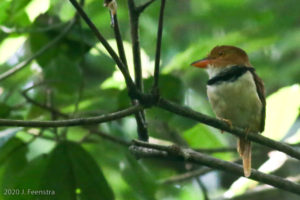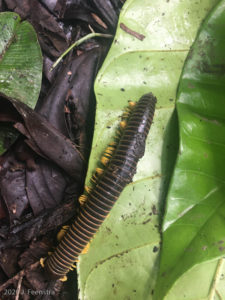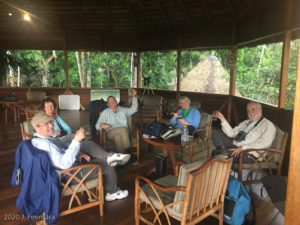
WINGS Tour: Amazon Lowlands, Sani Lodge
The gang: Dana, Harvey, Wendy, Dave, Frank, Susan, Jon (bird guy), Carlos (man of these woods), Marco (paddler, porter, and spotter)



It’s hard to reckon with a superlative like “most diverse place on earth,” but the week we spent in the Amazon lowlands in Ecuador felt like a proper adventure in that phrase. We were in another world out there: a world where we didn’t use or even see a car, a world where things like Wire-tailed Manakins and Citron-bellied Attilas and Silvered Antbird rule the day and Zigzag Herons and Great Potoos rule the night. Walking through primary rainforest and quiet canoe rides along dark forest lagoons was a regular daily activity. Mornings in a canopy tower were a magical way to see it all from above. We did all of this while being the guests of the Sani people at a lodge that was made for being a comfortable base in the midst of the wildest of the wild. Good food, access to forest, and excellent shelter where the bar was a place where one could have a cold beer away from the rain while maybe seeing a pile of scruffy Hoatzins or a Black-and-white Hawk Eagle.
Our Amazon week began with the adventure of getting out there. Sure, our day was basically a travel day, but the travel was pretty extreme. We started with a flight from Puembo out to Coca, first flying over the Andes, volcanoes Antisana and Cotopaxi off to our right. Next, once in the steamy, lowland heat, we boarded a motor canoe and motored down the Rio Napo for two-and-a-half hours. There were a few birds, but we were moving at speed and the jungle flew past. Then we disembarked at the river dock, walked down a boardwalk, and hopped into a paddle canoe for the last leg to the lodge. We dropped our things, grabbed a snack, got the orientation, and then someone in the kitchen saw an anaconda out the window, so we all had to look at that. It was a small one, only about 2 meters. We spent the rest of the afternoon puttering around the lodge grounds seeing Scarlet-crowned Barbet, a Rufescent Tiger-Heron sitting on a nest, a stately Capped Heron, and a noisy flock of Red-throated Caracaras. A few participants were even holding cold beers when this all happened. We had arrived.





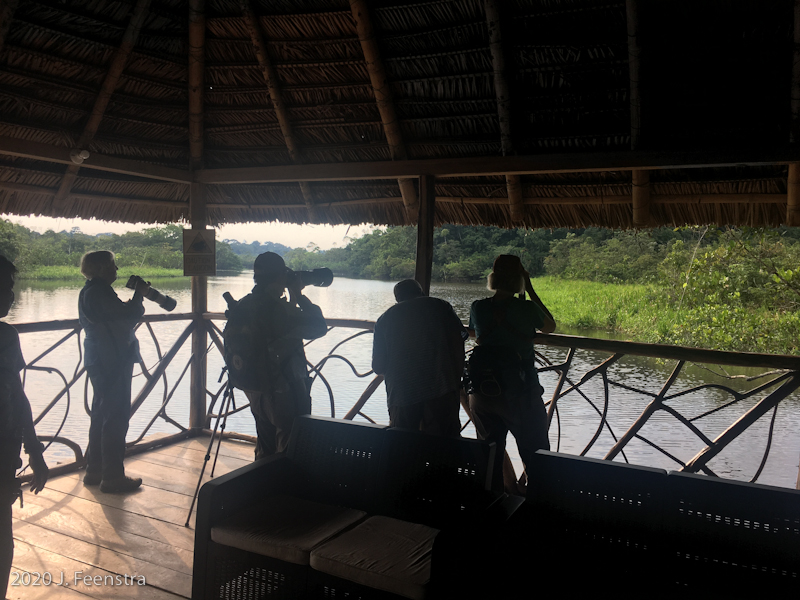
The next day was dominated by the tower. The steel reinforced spiral staircase up into the very loft of a great kapok tree, head and shoulders above the canopy of the lowland rainforest. And, to us, the birds came. Hardly had we been up there when we found a Pied Puffbird perched among the branches at eye level. Then another joined it, and we watched them interact, exchange food, mate, and pose confidingly for us. A lot more stuff came by, as well, including intensely blue Plum-throated Cotinga, big and loud White-throated Toucans, and some tanagers like Paradise, Green-and-gold, Opal-crowned, and Opal-rumped. We even had a hummingbird up there, a Gould’s Jewelfront that perched for a while before zooming right over our hats. As we rushed from one end of the platform to the other checking out the next thing, a Great Potoo was perched on a branch, giant eyes open when we first arrived, but narrowing to fine slits as the sun rose higher, its rest unaffected by our relative craziness. The afternoon we enjoyed a leisurely paddle about our lagoon seeing herons stalking, a pair of Tropical Screech Owls sleeping, and a line of Long-nosed Bats lined up on a stick poking from the water.
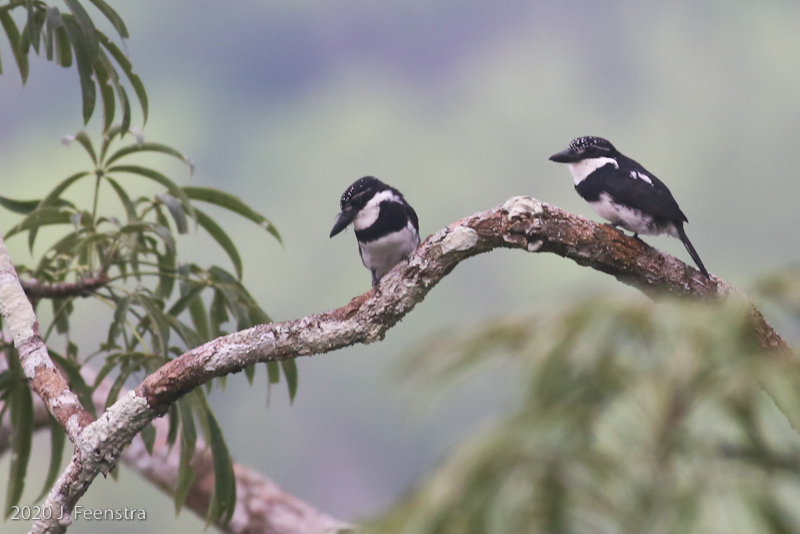



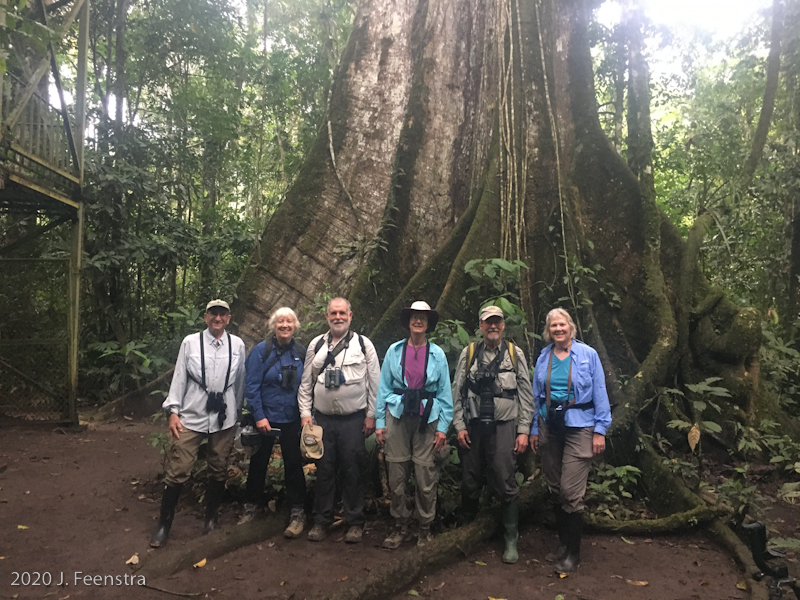


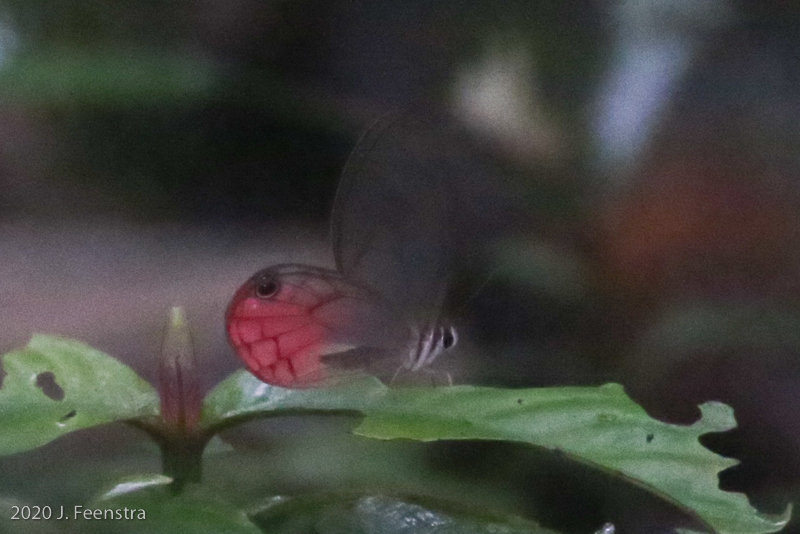
We dug deeper the following day. First we took a full morning hike through the primary forest. It was wet, dark, and ancient. Birding is tough on the forest floor and species are adapted about as much as they can be in avoiding detection. That said, we’re birders and our efforts paid off with looks at some understory skulkers like Dot-backed Antbird, and some skulky, yet somehow shockingly colorful things like Blue-crowned and Wire-tailed Manakins. In the afternoon we enjoyed something close to an other-worldly experience as we paddled the back-waters of our lagoon in the evening hours returning to the lodge after dark. The deafening cacophony of insects and frogs was punctuated by the roars of Great Potoo and the deep booming of Gray-winged Trumpeters. Fireflies sailed through the forest and bioluminescent stuff glittered in the water of the passing canoe. It was a long day, but it was worth it.
It happened that we had a single day with a lot of “big ticket” items, Amazonian marquee birds. We were headed for the river islands to poke around there, and not long after leaving the river dock bumped into an Amazonian Umbrellabird in a riverside cecropia tree. The island was decent and we found a pair of Castelnau’s Antshrikes, one of those island specialists. We then went to one of local guy Carlos’s secret spots, and, though we worked hard, we connected with a White-lored Antpitta. Seriously hard work. No visit to the Amazon is complete with a visit to one of the local ethnic community centers. At the community center of our host people, Sani Isla, we were treated to a delicious traditional lunch then told about the interesting birds in the neighboring yards. We walked off lunch a little by visiting a local farm whose owner has a knack for keeping track of roosting night birds. There we saw a nearly invisible Common Paraque asleep in the leaves and a pair of always wild-looking Crested Owls up in a tree. The ride back to the lodge, mostly quiet and peaceful, was interrupted by a bird that is anything but – a ridiculously-colored Cream-colored Woodpecker. Where else would there be a bright yellow woodpecker? We then had a little break, but finished up the day in the forest, in the dark, with one of western Ecuador’s most sought-after little residents, the enigmatic and superbly-named Zigzag Heron.





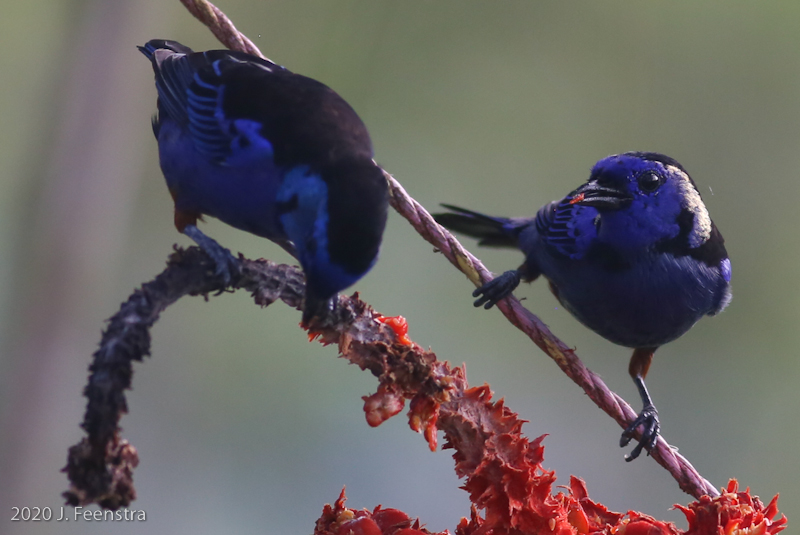


The next day we were back in the tower. Every time it’s always a little different. It seemed pretty much the same: the weather was good, a little sunny, some haze, all good. We saw a few repeat customers up there, but it was the new things and the different mix of things that was impressive. We added Turquoise Tanager and Blue Dacnis to our list of colorful little things. And, two Opal-rumped Tanagers (a repeat customer) this time decided to eat berries at nearly arm’s reach from the tower railing. A pair of Orange-bellied Euphonias were working on a nest right beneath the platform, and while watching that a Great Jacamar started calling nearby somewhere. We had to get back down to the ground and find that one. Just nearby the tower was a little blind setup from which we saw a stunning Wire-tailed Manakin posing. Despite its saturated colors, it somehow fit into the close forest. We started for the canoe and we got another Amazon experience, the classic thunderstorm. We heard it a little before it happened, enough time to stow cameras into dry bags, then the sky declared war on the ground and great hammers of rain beat on us all the way back to the lodge. While the wind blew and storm raged, it almost felt cool. Then it cleared, the sun came out, and it was back to a regular hot humid afternoon. No matter, though, the birds were still around and we had a fun afternoon around the lodge and in the nearby forest with Spangled Cotinga, both Black-fronted and White-fronted Nunbirds, and a troop of squirrel monkeys.
One of the amazing things about birding the Amazon is that everything is so different, trip to trip, day to day, or even hour to hour. There is so much diversity that just birding what appears to be the same habitat produces different results.
We spent the entire morning hiking in some forest off behind a residential area of the Sani people. It helped that our access point was the house of the parents of our indigenous guide, Carlos. Usually, birding tropical forest is a lot of walking in silence with occasional bouts of activity. This morning it seemed like the activity never stopped. We heard antbirds calling pretty much everywhere and managed decent looks at Peruvian Warbling-Antbird, Black-faced Antbird, Common Scale-baked Antbird, and Cinereous Antshrike. We ran into a few nice understory and sub-canopy flocks that included Flame-crested Tanager, Wing-barred Piprites, and Dugand’s Antwren, and found some assorted other treasures like Collared Puffbird, Rusty-belted Tapaculo, and Chestnut-belted Gnateater. Though the air was close and the heat was stifling, it was a fabulous day in the forest that never seemed to let up.






Our last full day was one of pretty constant rain. It does that sometimes in the rainforest. We spent our last full day mostly under the shelter of the bar area watching the lagoon and the bordering trees. We had some plans involving river islands and Yasuni Park that didn’t really happen, but it turned out to be a pleasure to wind down this way, like a victory lap. The highlight of the day was a Black-and-white Hawk-Eagle that popped up in a tree and gave cooperative scope views before flying around and stirring up all of the angry aracaris. Beyond that, though, we also had multiple Plum-throated Cotingas, Bare-necked Fruitcrows, tanagers, toucans, and whatever else fell within scope range as the rain fell. It slowed (briefly) and we took a trip out to the nearest river island. Naturally, the rain started back up in earnest just as we landed the boat. We did manage to see another couple of Amazonian Umbrellabirds and a pair of Ladder-tailed Nightjars before we learned our lesson and retreated back to the shelter of the lodge and its “birding by rear” comforts. So, it all worked out.


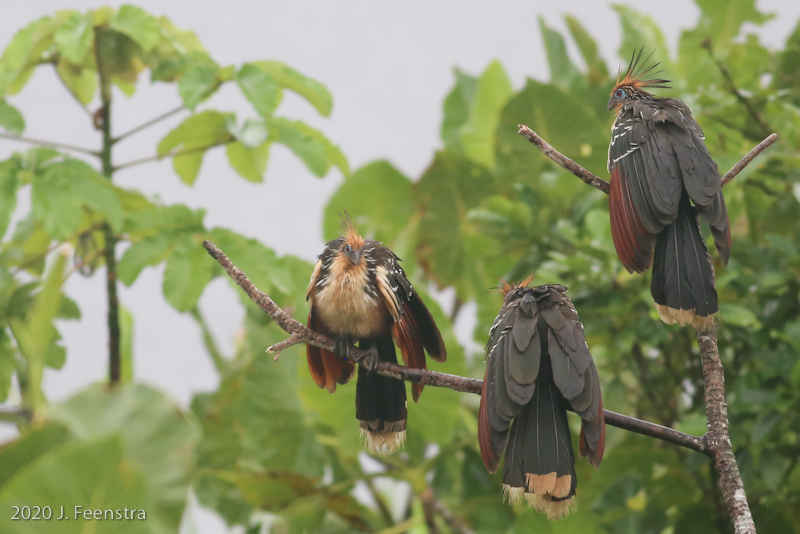
Then it was time to pack it all up and get back to civilization. Really, we were passing back from one world, the ancient world, to our own modern one. Our canoe paddle, our walk, the motorboat back up stream, then the airplane our transition to a place where the Amazon lowlands exist in our fondest memories of a magical week.



